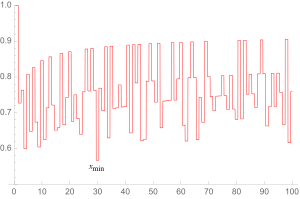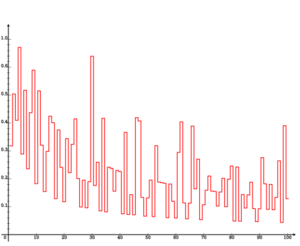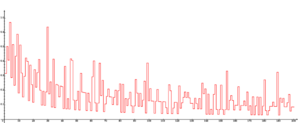Andrica's conjecture
Andrica's conjecture (named after Dorin Andrica) is a conjecture regarding the gaps between prime numbers.[1]
The conjecture states that the inequality
holds for all , where is the nth prime number. If denotes the nth prime gap, then Andrica's conjecture can also be rewritten as
Empirical evidence
Imran Ghory has used data on the largest prime gaps to confirm the conjecture for up to 1.3002 × 1016.[2] Using a table of maximal gaps and the above gap inequality, the confirmation value can be extended exhaustively to 4 × 1018.
The discrete function is plotted in the figures opposite. The high-water marks for occur for n = 1, 2, and 4, with A4 ≈ 0.670873..., with no larger value among the first 105 primes. Since the Andrica function decreases asymptotically as n increases, a prime gap of ever increasing size is needed to make the difference large as n becomes large. It therefore seems highly likely the conjecture is true, although this has not yet been proven.
Generalizations

As a generalization of Andrica's conjecture, the following equation has been considered:
where is the nth prime and x can be any positive number.
The largest possible solution for x is easily seen to occur for n=1, when xmax = 1. The smallest solution for x is conjectured to be xmin ≈ 0.567148... (sequence A038458 in the OEIS) which occurs for n = 30.
This conjecture has also been stated as an inequality, the generalized Andrica conjecture:
- for
See also
References and notes
- Guy, Richard K. (2004). Unsolved problems in number theory (3rd ed.). Springer-Verlag. ISBN 978-0-387-20860-2.
External links
- Andrica's Conjecture at PlanetMath
- Generalized Andrica conjecture at PlanetMath
- Weisstein, Eric W.. "Andrica's Conjecture". http://mathworld.wolfram.com/AndricasConjecture.html.
 |




